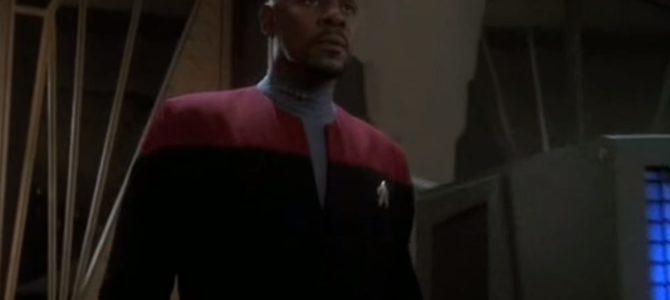
Alone among the various incarnations of Star Trek, the “Deep Space Nine” series included one of the great motivating factors of human behavior throughout our history: religion. In “Battle Lines,” the twelfth episode of the show’s first season, the viewer is introduced to the importance of religion to the Bajoran people. We also see the extent to which that devotion baffles non-Bajorans. It reflects the lack of common ground between religious and non-religious people in real life, both in 1993 when the episode aired, and even more a quarter-century later.
The Plot
As the episode begins, Kai Opaka (played by Camille Saviola) requests a tour of the station. The head of the Bajoran religion, she occupies an esteemed place in the planet’s society. She was also, as Kira explained in the series premiere, the only person on Bajor capable of uniting the people after they expelled the Cardassian occupation. Now, she comes to the station for the first time, causing surprise and confusion among everyone there.
From a window on the promenade, Opaka observed the wormhole, home of the interdimensional beings known as the Prophets—Bajor’s gods. She asks Sisko to take her through it and after expressing concern for the safety of an unnecessary voyage, he agrees. As the foreshadowing suggests, this will be an unusual trip.
Opaka’s motivation for this journey is still a mystery to the crew taking her there (Sisko, Kira, and Bashir). When they pass into the Gamma Quadrant, see seems expectant, as though she knew something was about to happen. When the ship detects an unknown signal, they investigate with the Kai’s blessing. Inevitably, the source of the signal is a satellite orbiting a moon, which then attacks the Federation vessel. They are forced to make a rough landing.
After the crash, they are shocked to discover Opaka died on impact. Before they can begin to assess that tragedy and before Kira can mourn her religious leader’s passing, they encounter armed aliens, who take them back to their caves. The group turns out to be the “Ennis,” led by Shel-La (played by Jonathan Banks, later a recurring character on “Breaking Bad.”) He explains that they and their enemies, the “Nol-Ennis,” were sentenced to live on the moon forever when their planet’s leaders found it impossible to make peace between them.
The word “forever” becomes key here. After a raid by the Nol-Ennis leaves many dead, Kai Opaka appears at the entrance to the caves, alive and seemingly well. Bashir examines her to find that some sort of nanotechnology has reanimated her, including her memories and personality. As the “dead” Ennis fighters begin to revive, they all realize that the same force is at work in them.
Violence Is Futile
Here we have a nod to one of Star Trek’s persistent themes: the futility of violence and war. The moon’s inhabitants are so warlike that even death does not stop them. Instead, they are condemned—by the “enlightened” members of their society, presumably—to war with each other forever. Like Prometheus, they die each time and are resurrected, but the resurrection is not of the Christian sort. Here, they are brought back not to later ascend into heaven to repeat their violent lives, again and again, a vicious and futile reincarnation.
Even worse is Bashir’s realization that the tiny machines that reanimated them cannot exist outside the moon they inhabit. If they leave, they die—permanently. They were not sent there to learn the error of their ways, because even if they did, they would still not be allowed to leave. Instead, they serve as an object lesson for more enlightened people, a humanoid zoo for whatever distance civilization imprisoned them there.
The same living death now applies to Opaka. As Sisko begins to tell her this, she cuts him off, saying that she plans to remain there anyway. Opaka knew, she says, that she would not return to Bajor. Bringing peace to these most warlike of people, she believes, is her destiny. Her calm acceptance of the fate she has foreseen baffles Sisko, although he has no choice but to accept it—Opaka is stuck there anyway. She says that her spirit and Sisko’s will meet again, and they do, but only in mystical visions; as far as we know, Opaka never leaves the planet again. (There was a 2002 novel about her fate, and that of the Ennis and Nol-Ennis, but nothing in the “official” canon of the show.)
Already, the world of endless war has had some effect on Kira, who begins to examine her life—spent entirely in fighting the Cardassians—and wonders what to do now that the battle has been won. It is a metaphor for all of Bajor, and a theme to which the show returns often. What do freedom fighters do once they get the freedom to which they bent all their efforts?
Back on the station, the crew’s absence—and the Kai’s—has been noted. Dax and O’Brien search for the missing ship, with O’Brien working his usually technological magic to track them down. Before they can leave, Bashir tells Shel-La that he thinks he can find a way to turn the reanimator machines off, letting the Ennis and Nol-Ennis die permanently. Shel-La is interested—but only if Bashir’s efforts can be weaponized against the Nol-Ennis, leaving the Ennis as the ultimate victors in the endless war.
Clearly, the message of peace has a long way to go. In a way, Opaka’s decision to remain (assuming she had a choice) is one of accepting her talent as a peacemaker and not trying to adapt to a new life on a planet where peace has been achieved. Meanwhile, Kira returns to the station forced to decide her fate: unreconciled warrior, or a state-builder in a new era of peace?









